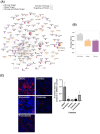Molecular interaction networks and drug development: Novel approach to drug target identification and drug repositioning
- PMID: 36468661
- PMCID: PMC10107166
- DOI: 10.1096/fj.202201683R
Molecular interaction networks and drug development: Novel approach to drug target identification and drug repositioning
Abstract
Conventional drug discovery requires identifying a protein target believed to be important for disease mechanism and screening compounds for those that beneficially alter the target's function. While this approach has been an effective one for decades, recent data suggest that its continued success is limited largely owing to the highly prevalent irreducibility of biologically complex systems that govern disease phenotype to a single primary disease driver. Network medicine, a new discipline that applies network science and systems biology to the analysis of complex biological systems and disease, offers a novel approach to overcoming these limitations of conventional drug discovery. Using the comprehensive protein-protein interaction network (interactome) as the template through which subnetworks that govern specific diseases are identified, potential disease drivers are unveiled and the effect of novel or repurposed drugs, used alone or in combination, is studied. This approach to drug discovery offers new and exciting unbiased possibilities for advancing our knowledge of disease mechanisms and precision therapeutics.
Keywords: ligand; pathway; pharmacology; therapy.
© 2022 The Author. The FASEB Journal published by Wiley Periodicals LLC on behalf of Federation of American Societies for Experimental Biology.
Figures












References
-
- Ehrlich P. Die Behandlung der Syphilis mit dem Ehrlichschen Präparat 606. Deutsche Med Wochenschr. 1910;41:1893‐1896.
-
- Laermann‐Nguyen U, Backfisch M. Innovation crisis in the pharmaceutical industry? A survey. SN Bus Econ. 2021;1:164.
-
- Schork NJ. Time for one‐person trials. Nature. 2015;520:609‐611. - PubMed
-
- Drew KLM, Baiman H, Khwanounjoo P, Yu B, Reynisson J. Size estimation of chemical space: how big is it? J Pharm Pharmacol. 2012;64:490‐495. - PubMed
Publication types
MeSH terms
LinkOut - more resources
Full Text Sources

